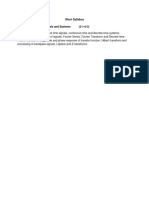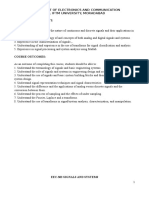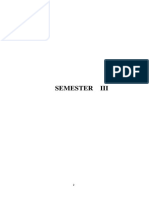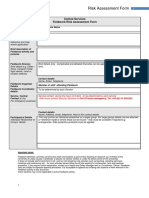0 ratings0% found this document useful (0 votes)
102 viewsECE1004 Signals-And-Systems ETH 2 AC39
ECE1004 Signals-And-Systems ETH 2 AC39
Uploaded by
Chandan yadavThis document outlines the course ECE1004 Signals and Systems. The course has 8 modules that cover fundamental signals, signal operations, system concepts, Fourier analysis of continuous and discrete time signals, convolution, correlation, and system analysis using Laplace and z-transforms. The course aims to help students differentiate signal types, understand concepts like stability, and apply Fourier transforms, series, and z-transforms to analyze signals and systems. Assessment focuses on student learning outcomes related to these topics. The course has 30 total lecture hours and recommends 3 textbooks for reference.
Copyright:
© All Rights Reserved
Available Formats
Download as PDF, TXT or read online from Scribd
ECE1004 Signals-And-Systems ETH 2 AC39
ECE1004 Signals-And-Systems ETH 2 AC39
Uploaded by
Chandan yadav0 ratings0% found this document useful (0 votes)
102 views2 pagesThis document outlines the course ECE1004 Signals and Systems. The course has 8 modules that cover fundamental signals, signal operations, system concepts, Fourier analysis of continuous and discrete time signals, convolution, correlation, and system analysis using Laplace and z-transforms. The course aims to help students differentiate signal types, understand concepts like stability, and apply Fourier transforms, series, and z-transforms to analyze signals and systems. Assessment focuses on student learning outcomes related to these topics. The course has 30 total lecture hours and recommends 3 textbooks for reference.
Original Description:
syllabus
Copyright
© © All Rights Reserved
Available Formats
PDF, TXT or read online from Scribd
Share this document
Did you find this document useful?
Is this content inappropriate?
This document outlines the course ECE1004 Signals and Systems. The course has 8 modules that cover fundamental signals, signal operations, system concepts, Fourier analysis of continuous and discrete time signals, convolution, correlation, and system analysis using Laplace and z-transforms. The course aims to help students differentiate signal types, understand concepts like stability, and apply Fourier transforms, series, and z-transforms to analyze signals and systems. Assessment focuses on student learning outcomes related to these topics. The course has 30 total lecture hours and recommends 3 textbooks for reference.
Copyright:
© All Rights Reserved
Available Formats
Download as PDF, TXT or read online from Scribd
Download as pdf or txt
0 ratings0% found this document useful (0 votes)
102 views2 pagesECE1004 Signals-And-Systems ETH 2 AC39
ECE1004 Signals-And-Systems ETH 2 AC39
Uploaded by
Chandan yadavThis document outlines the course ECE1004 Signals and Systems. The course has 8 modules that cover fundamental signals, signal operations, system concepts, Fourier analysis of continuous and discrete time signals, convolution, correlation, and system analysis using Laplace and z-transforms. The course aims to help students differentiate signal types, understand concepts like stability, and apply Fourier transforms, series, and z-transforms to analyze signals and systems. Assessment focuses on student learning outcomes related to these topics. The course has 30 total lecture hours and recommends 3 textbooks for reference.
Copyright:
© All Rights Reserved
Available Formats
Download as PDF, TXT or read online from Scribd
Download as pdf or txt
You are on page 1of 2
L T P J C
ECE1004 Signals and Systems
2 0 0 4 3
Prerequisite: MAT1011
Objectives:
Study of characteristics of fundamental signals like unit impulse, unit step, Ramp and
exponentials.
To study various operations on the signals.
Study of systems as linear, time invariant, causal and stable ones.
Introduction of concept of linear convolution and correlation for LTI systems.
Study of different forms and properties of Fourier transform.
Study of utility of Fourier transform for analysis of signals passed through systems.
Laplace Transform as a tool for analysis of continuous systems.
Z-transform as a tool for analysis of discrete systems.
Expected Outcome:
1. Differentiate between various types of signals like unit impulse, unit step, ramp and exponentials.
2. Understand the concepts of damped sinusoids and periodicity.
3. Understand the concept of even and odd signals.
4. Understand the concept of stability of a system.
5. Apply the Fourier series and Fourier transform for analysis of continuous signals.
6. Calculate the power spectral density of signals
Student Learning Outcomes (SLO): 1,2,6,7,13 and 17
Module:1 Introduction to Signals: 3 hours SLO: 1,2
Continuous-time and Discrete-time Signals: Representation of signals, Signal classification, Types of
signals, Operations on signals - Scaling, Shifting, Transformation of independent variables, Sampling.
Module:2 Systems Concepts: 3 hours SLO: 1,2
Continuous-time and Discrete-time Systems: Classification of systems - Static and dynamic, Linear
and non-linear, Time-variant and time-invariant, Causal and non-causal, Stable and unstable, Impulse
response and step response of systems.
Module:3 Fourier Analysis of Continuous-time Signals: 4 hours SLO: 1,2,7,17
Introduction to Fourier series, Gibbs Phenomenon, Continuous-time Fourier transform (CTFT),
Existence, Properties, Magnitude and phase response, Parseval’s theorem, Inverse Fourier transform.
Module:4 Fourier Analysis of Discrete-time Signals: 4 hours SLO: 1,2,7,17
Discrete-time Fourier transform, Properties, Inverse discrete-time Fourier transform, Comparison
between CTFT and DTFT.
Module:5 Convolution and Correlation: 4 hours SLO: 1,2,7,17
Continuous-time convolution, Convolution sum, Correlation between signals, Cross correlation,
Autocorrelation, Energy spectral density, Power spectral density.
Module:6 System Analysis using Laplace transform: 5 hours SLO: 1,2,7,17
Relation between Laplace and Fourier transforms, Properties, Inverse Laplace transform, Solution to
differential equations using Laplace transform, Region of convergence, Stability analysis.
Module:7 System Analysis using z-Transform: 5 hours SLO: 1,2,7,17
z-transform, Properties, s-plane to z-plane mapping, Inverse z-transform, Solution to difference equations
using z-transform, Region of convergence, Stability analysis.
Module:8 Contemporary Topics: 2 hours SLO: 1,2,7,17
Total Lecture: 30 hours
Text Books:
1. Signals and Systems, second edition-P. Rama Krishna Rao and Shankar Prakriya- Mc-
Graw Hill, 2013.
Reference Books:
1. Signals and systems, second edition-Alan. V. Oppenheim, Alan. S. Willsk,S. Hamid
Nawab, PHI learning Pvt ltd,2001
2. Signal processing and linear systems- B. P. Lathi, Oxford university press,2009
3. Signals and systems, second edition - Simon Haykin, Barry VanVeen, Wiley, Wiley
India, 2007.
List of Challenging Projects: SLO: 6 and 13
1. EMG Muscle Sensor based DC Motor Control
2. Speech recognition to Control home automation system
3. Cell phone signal enhancing router
4. Speaker recognition Security system
5. Analyzing ECG signal to measure the heart rate
6. Stability analysis of Automotive control system using Laplace / Z transform
You might also like
- Pheasyque Muscular EbookDocument155 pagesPheasyque Muscular EbookJM301283% (6)
- U.S. Joint Warfighting Cloud Capability - Required CapabilitiesDocument5 pagesU.S. Joint Warfighting Cloud Capability - Required CapabilitiesGeekWireNo ratings yet
- Hachi's PermitDocument1 pageHachi's PermitBebelyn AlquizarNo ratings yet
- DamodaranDocument49 pagesDamodaranSukanta ChatterjeeNo ratings yet
- EEE1005 Signals and Systems L T P J C 3 0 0 0 3 Pre-Requisite MAT2002 Syllabus Version Anti-Requisite Course ObjectivesDocument3 pagesEEE1005 Signals and Systems L T P J C 3 0 0 0 3 Pre-Requisite MAT2002 Syllabus Version Anti-Requisite Course ObjectivesNathan ShankarNo ratings yet
- Bece202l Signals-And-Systems TH 1.0 65 Bece202lDocument3 pagesBece202l Signals-And-Systems TH 1.0 65 Bece202lMohit SubramaniamNo ratings yet
- Signals 3Document2 pagesSignals 3AARAV KUMARNo ratings yet
- EC202 Signals & SystemsDocument3 pagesEC202 Signals & Systemsanupvasu0% (1)
- Signal and System SyllabusDocument2 pagesSignal and System SyllabusVinay PrakashNo ratings yet
- Subject (Theory) : SIGNALS AND SYSTEMS: Course ObjectiveDocument2 pagesSubject (Theory) : SIGNALS AND SYSTEMS: Course ObjectivePrafulla Durgadhar GawandeNo ratings yet
- Complete - Lec01-06 - CT Signals and TD AnalysisDocument103 pagesComplete - Lec01-06 - CT Signals and TD AnalysisDaniya AbbasiNo ratings yet
- Introduction To Signals and SystemsDocument3 pagesIntroduction To Signals and SystemsFaisal MushtaqNo ratings yet
- Signals and SystemDocument2 pagesSignals and Systemjeet kumarNo ratings yet
- EC109 Signals and System Analysis: L-T-P: 3-1-0 Total 42 LecturesDocument2 pagesEC109 Signals and System Analysis: L-T-P: 3-1-0 Total 42 LecturesSNo ratings yet
- CORE Theory Subjects: A. Outline of The CourseDocument2 pagesCORE Theory Subjects: A. Outline of The CourseArpita SinghNo ratings yet
- Signal and System: Introduction To Signals and SystemsDocument2 pagesSignal and System: Introduction To Signals and SystemsAnonymous HyOfbJ6No ratings yet
- Signals and SystemsDocument1 pageSignals and Systemsडाँ सूर्यदेव चौधरीNo ratings yet
- 15EC44 NotesDocument126 pages15EC44 NoteslathavenkyNo ratings yet
- Signals and SystemsDocument174 pagesSignals and Systemsjale charitha reddy75% (4)
- Chhattisgarh Swami Vivekanand Technical University, BhilaiDocument25 pagesChhattisgarh Swami Vivekanand Technical University, BhilaiPiyush KumarNo ratings yet
- Ece206 Signals-And-systems TH 1.20 Ac29Document2 pagesEce206 Signals-And-systems TH 1.20 Ac29netgalaxy2010No ratings yet
- SS Lecture Notes Mod 1Document40 pagesSS Lecture Notes Mod 1Konesh KumarNo ratings yet
- Lecture PlanDocument19 pagesLecture PlanSougata GhoshNo ratings yet
- EC8352 - SS - All in One PDFDocument140 pagesEC8352 - SS - All in One PDFCHARANNo ratings yet
- Signals and SystemDocument4 pagesSignals and SystemAman GuptaNo ratings yet
- Maulana Abul Kalam Azad University of Technology, West Bengal (Formerly West Bengal University of Technology)Document2 pagesMaulana Abul Kalam Azad University of Technology, West Bengal (Formerly West Bengal University of Technology)DeepthikattaNo ratings yet
- SasDocument140 pagesSasGk VasanthNo ratings yet
- Ec6303 Signals and SystemsDocument2 pagesEc6303 Signals and SystemsSam PaulNo ratings yet
- Signals and SystemsDocument3 pagesSignals and SystemsDeepthikattaNo ratings yet
- EC202 Signals and SystemsDocument2 pagesEC202 Signals and SystemsThulasi M SanthiNo ratings yet
- IARE ECE SS SyllabusDocument3 pagesIARE ECE SS SyllabussnbvshcvdscNo ratings yet
- EC202 Signals & SystemsDocument2 pagesEC202 Signals & SystemsNishiya VijayanNo ratings yet
- ESA syllabus (1)Document3 pagesESA syllabus (1)Snataksuraj KarajadaNo ratings yet
- EC6303 Signals and SystemsDocument84 pagesEC6303 Signals and SystemsSaffanah ShaukathNo ratings yet
- EC8352 - by EasyEngineering - Net 1 PDFDocument140 pagesEC8352 - by EasyEngineering - Net 1 PDFlolo boloNo ratings yet
- Ece220:Signal and Systems: Page:1/2 Print Date: 4/14/2016 9:14:41 PMDocument2 pagesEce220:Signal and Systems: Page:1/2 Print Date: 4/14/2016 9:14:41 PMtarun_nooglerNo ratings yet
- Signals and Systems: BooksDocument1 pageSignals and Systems: Booksfaizan bariNo ratings yet
- EC8352 - by EasyEngineering - Net 1Document140 pagesEC8352 - by EasyEngineering - Net 1Mary Roshia PeterNo ratings yet
- Lesson Plan of Signals and SystemsDocument3 pagesLesson Plan of Signals and SystemsSantosh KumarNo ratings yet
- Course Plan and The Evaluation Plan: Signals & SystemsDocument2 pagesCourse Plan and The Evaluation Plan: Signals & Systemsanon_401388365No ratings yet
- R 20 Signals and SystemsDocument174 pagesR 20 Signals and SystemsTHE INDIAN ATLASNo ratings yet
- ECE2005 - Probability Theory and Random Processes - 16.12.15 - 10.20PMDocument3 pagesECE2005 - Probability Theory and Random Processes - 16.12.15 - 10.20PMPhillip JebakumarNo ratings yet
- 13.302 Signals & Systems (At) : L-T-P: 3-1-0 Credits: 4Document7 pages13.302 Signals & Systems (At) : L-T-P: 3-1-0 Credits: 4Surya TejaNo ratings yet
- ECE2005 Probability Theory and Random Processes TH 1 AC39Document2 pagesECE2005 Probability Theory and Random Processes TH 1 AC39Anup PatelNo ratings yet
- Signals and Systems SyllabusDocument3 pagesSignals and Systems SyllabusSeema P DiwanNo ratings yet
- Signals and SystemsDocument183 pagesSignals and Systemssidhken5425No ratings yet
- Signals and Systems EXTCDocument4 pagesSignals and Systems EXTCdindinpatalamNo ratings yet
- Se Entc (IV Sems - 2019)Document36 pagesSe Entc (IV Sems - 2019)Chinmay KulkarniNo ratings yet
- ECT 204 SIGNALS AND SYSTEMS - CompressedDocument4 pagesECT 204 SIGNALS AND SYSTEMS - Compressedranjithkumar.painamNo ratings yet
- Signals and SystemsDocument3 pagesSignals and SystemsArjun Arjun100% (1)
- Syllabus 2013 PDFDocument41 pagesSyllabus 2013 PDFAbhay RameshNo ratings yet
- B.Tech - ECE Syllabus IV Year - Signal and System 3014Document3 pagesB.Tech - ECE Syllabus IV Year - Signal and System 3014tarang srivasNo ratings yet
- Course Code Course Name Course Structure Ececc05 Signal and Systems 3-1-0 L-T-PDocument2 pagesCourse Code Course Name Course Structure Ececc05 Signal and Systems 3-1-0 L-T-PSuvdeep NayakNo ratings yet
- AB Signal-Sp24Document7 pagesAB Signal-Sp24samranhameed21No ratings yet
- Signals and Systems 3/0/0/3 Course Pre-RequisitesDocument2 pagesSignals and Systems 3/0/0/3 Course Pre-RequisitesAjithanieNo ratings yet
- Course Plan and Evaluation Plan: 3-1-0 4 Nil Electronics & Communication Engg. DR Sumam David SDocument3 pagesCourse Plan and Evaluation Plan: 3-1-0 4 Nil Electronics & Communication Engg. DR Sumam David SSushil1998No ratings yet
- EC6303 Signals and Systems PDFDocument82 pagesEC6303 Signals and Systems PDFkiranNo ratings yet
- EE2001E SIGNAALS AND SYSTEMSDocument8 pagesEE2001E SIGNAALS AND SYSTEMSshiva.kumar1n381lNo ratings yet
- Ss SyllabusDocument2 pagesSs SyllabusVenkatGollaNo ratings yet
- Signal and Systems: Beg 334 Ec Year: III Semester: IDocument2 pagesSignal and Systems: Beg 334 Ec Year: III Semester: IPratik BajracharyaNo ratings yet
- EE305 - Signals and Systems SyllabusDocument2 pagesEE305 - Signals and Systems SyllabusShepherd SimukondaNo ratings yet
- Time-Frequency Domain for Segmentation and Classification of Non-stationary Signals: The Stockwell Transform Applied on Bio-signals and Electric SignalsFrom EverandTime-Frequency Domain for Segmentation and Classification of Non-stationary Signals: The Stockwell Transform Applied on Bio-signals and Electric SignalsNo ratings yet
- BIO152 Syllabus - Fall 2010Document6 pagesBIO152 Syllabus - Fall 2010Mercedeh SNo ratings yet
- Method Statement of Sliding DoorDocument3 pagesMethod Statement of Sliding Doorarabiangulfdoorest2008No ratings yet
- Bili-250 BrochureDocument2 pagesBili-250 BrochureOkinbaloye RidwanNo ratings yet
- Construction Risk Assessment Sample Form PDFDocument4 pagesConstruction Risk Assessment Sample Form PDFZaka Ur RehmanNo ratings yet
- 9 M S of Management PDFDocument76 pages9 M S of Management PDFkegnata60% (5)
- CISS 120 SyllabusDocument4 pagesCISS 120 SyllabusalbaqobeNo ratings yet
- Bruksanvisning Kegerator KeglandDocument14 pagesBruksanvisning Kegerator KeglandpaulNo ratings yet
- STO ProcessDocument6 pagesSTO ProcessSantosh KumarNo ratings yet
- QuiQ Dci Data Sheet PDFDocument2 pagesQuiQ Dci Data Sheet PDFkarlosc17No ratings yet
- Exam Information: Course Code and Name Semester Exam Type Exam Date and Time Exam DurationDocument8 pagesExam Information: Course Code and Name Semester Exam Type Exam Date and Time Exam DurationNima MoaddeliNo ratings yet
- Summary:: Anandhu Raj R.SDocument4 pagesSummary:: Anandhu Raj R.SSujith VSNo ratings yet
- Karcher KM 90 60 R Rider Sweeper Parts ListDocument61 pagesKarcher KM 90 60 R Rider Sweeper Parts ListDavid VaquerizoNo ratings yet
- Cbs Modular Bridge Drawings t3-8m SpanDocument40 pagesCbs Modular Bridge Drawings t3-8m SpanEncik ComotNo ratings yet
- Banking NotesDocument30 pagesBanking NotesAditi RahurikarNo ratings yet
- Capacitors: High QualityDocument220 pagesCapacitors: High Qualitywillian GaldinoNo ratings yet
- ADMA 1 CompressedDocument18 pagesADMA 1 CompressedraviNo ratings yet
- Vocinti_MAL_ENGDocument1 pageVocinti_MAL_ENGpaliwalmonica86No ratings yet
- 05-08-2019 AerospaceDocument190 pages05-08-2019 Aerospacekhushboo chandaniNo ratings yet
- Proving FlightsDocument14 pagesProving Flightsjanhavi100% (1)
- Leaflet Sienta 2021Document4 pagesLeaflet Sienta 2021郭哲宏No ratings yet
- DT0423 (Items Required For MVPI) : Electrical WorkDocument1 pageDT0423 (Items Required For MVPI) : Electrical WorkTruck TrailerNo ratings yet
- Piis001650852200628x PDFDocument12 pagesPiis001650852200628x PDFAriana HurtadoNo ratings yet
- GROUP 6 ComparativeDocument22 pagesGROUP 6 ComparativeChester Alvin DomincelNo ratings yet
- SONiC Community 2022 Update and BeyondDocument19 pagesSONiC Community 2022 Update and Beyondngotu142No ratings yet
- Maths Assignment: Amrita Vishwa VidyapeedamDocument13 pagesMaths Assignment: Amrita Vishwa VidyapeedamAJ AjayNo ratings yet
- Variable PayDocument1 pageVariable PayRamya NairNo ratings yet

























































































